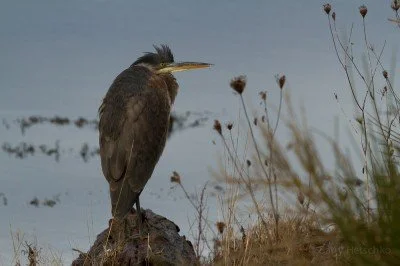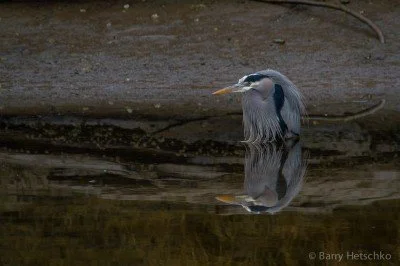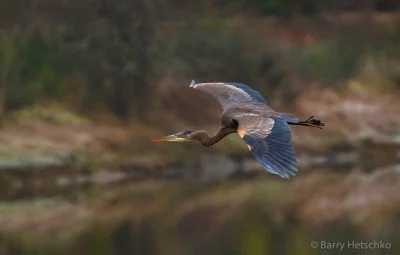Robin's Bay Blog: the Cowichan Bay Blue-heron Colony
Many locals will be aware of the heronry just across the road from the Cowichan Estuary Nature Centre located at the edge of Cowichan Bay Village. This large colony was recently evaluated by Trudy Chatwin - Endangered Species Biologist with the B.C. Ministry of Environment, also known to some locally now through her work with the Bluebird reintroduction program around the Maple Bay GOERT and Somenos/Quamichan areas. She evaluated 74 heron nests (down from 97 years ago) and seemingly a fairly successful breeding season with little predation from their main antagonist, the resurging Bald Eagles, who have engendered a strong comeback since the dismal DDT era that affected so many of the higher up of the feeding chain predators via egg production quality etc. This local group is a key part of the small geographic range of the West Coast fannini subspecies of the Great Blue (Ardea Herodias).The Parks Commission of the CVRD has been instrumental in extending the reach of the Wessex Ravine Park to encompass the new colony breeding area that moved almost a decade ago from the nearby ravine, which was originally so protected in impenetrable woods down in a bowl. Resident Kerrie Talbot informs me they nested in Alders there surrounded by soft maples and a coniferous mix. The current colony is sheltered in maples which act to shield the nests from flyby eagles. The eagles can wreak havoc with a colony when exposed, as likely happened with the incursion of subdivision work at the old colony that saw bulldozing and tree chopping right up to the heronry itself. Suddenly the whole colony decides to move - they pull up stakes and frequently make use of the old nesting materials to supply the new location. Trudy described this colony as a nursery heronry for surrounding areas.Expert and long time local birder, Derrick Marven tells me there were some 2 colonies at Quamichan and another on Lane Road off Drinkwater behind the Mall in the cedar and mixed woods area. We’re not sure if that one is still active but certainly he felt overall heron numbers in the area have been spiraling downwards since his arrival from Ontario decades ago. He also felt the whole Cowichan Estuary and Bay has lost a lot of feeding capacity for visiting shorebirds compared to back in the day. Certainly the alterations by Ducks Unlimited took some great prime feeding mudflats away on Dock Road and the Dykes’ zones but the whole shorebird population of the Bay has starkly plummeted he observed, in contrast to the maintaining health of Island shorebird visits and breeding in general. All this speaks to rather rapid changes in the health of our Estuary where many have related that the fish were so abundant, the waters visibly teemed with them only 4 decades ago. The Chinook is the flagship species but only emblematic of the many others, less notable in their profile. And herons + their young will consume a lot of fish through a season. Derrick noted that herons change their feeding habits and extend their range into the winter and early spring seasons. As breeding commences they stick closer to home, where the pair observe shifts to care for the nest. The partner is fishing afar whilst the other parent is sentry in nest guarding and nurturing the young. Regurgitated fish is a yummy prospect that goes down well in these rife colonies.Such “primitive” looking creatures arouse our fascination and colonies at Stanley and Beacon Hill Park have garnered a lot of press time over the years. It is common for me to observe from my windows a heron or two headed back for the colony and roosting area at dusk, with me living the other side of Tzouhalem on the edge of Maple Bay village. Derrick says they certainly venture over to Crofton etc these days outside the breeding season. Based on Trudy’s observation we can hopefully anticipate colonies stemming out further in future.Herons are of course part of the dynamic jigsaw puzzle ecological interconnection, woven in as fishers, froggers, crabbers etc. Not all with home garden ponds will be impressed with this magnificent creature’s finely honed skills for catching fish and the likes. They usually prefer seclusion from humans but Stanley Park and Beacon Hill show they can tolerate human presence as long as it is not overly threatening or disturbing. There appear to be a handful or 2 of colonies in SE Vancouver Island such as Protection Island, Saanich Peninsula etc. There is a very large colony of around 400 active nests just across the border at Pt. Roberts. The birds are clearly evolved to gain advantage in communal nesting and follow their herding instinct around the heronries with the behaviour and activities that surround those. But they hunt alone.The predator Bald Eagles’ success story was echoed in my former home in the York Region north of Toronto. They were nesting there for the first time in decades in 2009/10 and very close to the large Heronry located at the South end of Lake Simcoe’s Cook’s Bay. The 2 avian species seemed to be wrapped up with each other but the Eagles cannot detract all the Herons’ obvious successes as hunters in their own right. Many such creatures adapt and migrate quickly with the last major glacial age on this Island between 15,000 and 29,000 yrs ago. As Derrick observes, we cannot know all the factors that can affect them with warming climates etc but we can be assured that human incursion and upheaval of habitat will send ricochets down the ecological chain of life to our own eventual detriment. I am delighted that so many are intrigued and drawn towards birds through this wonderful specimen of evolutionary refinement.These terrific photos are thanks to Barry Hetschko from the Gallery on this CERCA site (make sure to catch Barry’s other stunning compositions in this Bay area in that Gallery).The fannini subspecies of Great Blue Heron is listed under the Species at Risk Act (SARA), is subject to protections and prohibitions under the Federal Migratory Birds Convention Act and BC Wildlife Act and is Identified Wildlife under the Forest and Range Practices Act. Habitat for this species may also be governed under provincial and federal regulations including the Fish Protection Act and Federal Fisheries Act as well as Regional and local municipal bylaws.



